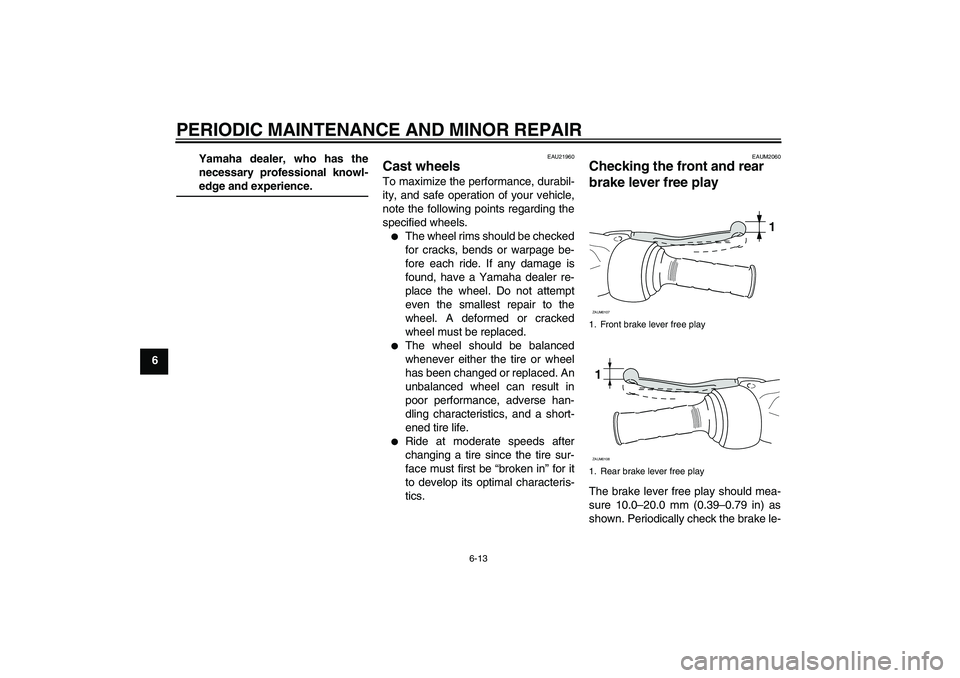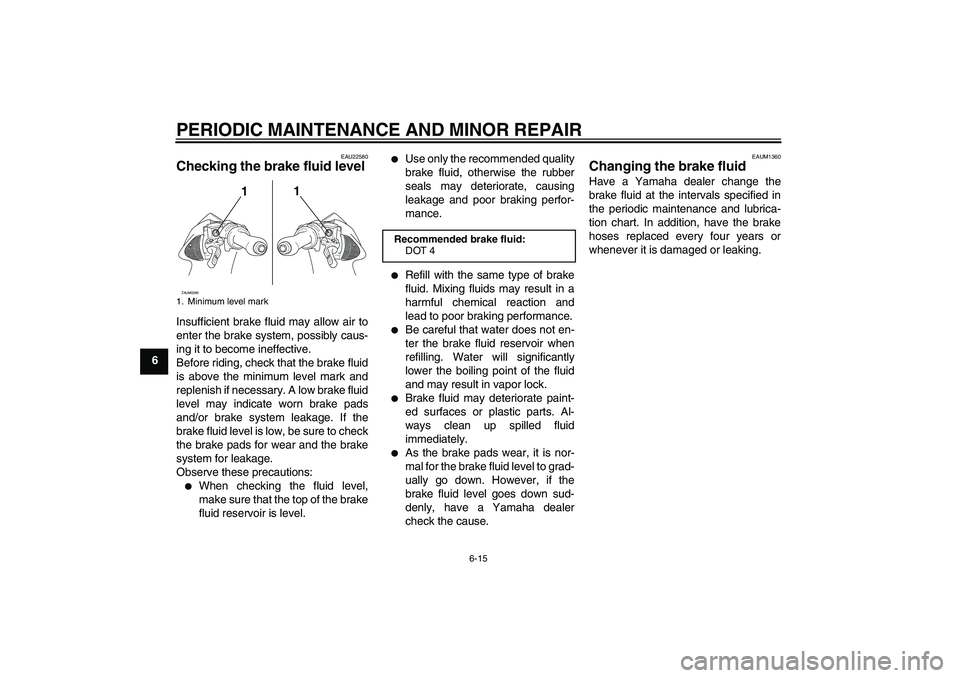Page 44 of 68

PERIODIC MAINTENANCE AND MINOR REPAIR
6-13
6Yamaha dealer, who has the
necessary professional knowl-
edge and experience.
EAU21960
Cast wheels To maximize the performance, durabil-
ity, and safe operation of your vehicle,
note the following points regarding the
specified wheels.�
The wheel rims should be checked
for cracks, bends or warpage be-
fore each ride. If any damage is
found, have a Yamaha dealer re-
place the wheel. Do not attempt
even the smallest repair to the
wheel. A deformed or cracked
wheel must be replaced.
�
The wheel should be balanced
whenever either the tire or wheel
has been changed or replaced. An
unbalanced wheel can result in
poor performance, adverse han-
dling characteristics, and a short-
ened tire life.
�
Ride at moderate speeds after
changing a tire since the tire sur-
face must first be “broken in” for it
to develop its optimal characteris-
tics.
EAUM2060
Checking the front and rear
brake lever free play The brake lever free play should mea-
sure 10.0–20.0 mm (0.39–0.79 in) as
shown. Periodically check the brake le-1. Front brake lever free play
1. Rear brake lever free play
1
ZAUM01071ZAUM0108
Page 45 of 68
PERIODIC MAINTENANCE AND MINOR REPAIR
6-14
6 ver free play and, if necessary, have a
Yamaha dealer check the brake sys-
tem.
WARNING
EWA10640
An incorrect brake lever free play in-
dicates a hazardous condition in the
brake system. Do not operate the ve-
hicle until the brake system has
been checked or repaired by aYamaha dealer.
EAU22340
Checking the front and rear
brake pads The front and rear brake pads must be
checked for wear at the intervals spec-
ified in the periodic maintenance and
lubrication chart. To check the brake
pad wear, measure the lining thick-ness. If the lining thickness is less than
2.0 mm (0.08 in), have a Yamaha deal-
er replace the brake pads as a set.1. Lining thickness
1. Lining thickness
1
ZAUM0277
1
ZAUM0278
Page 46 of 68

PERIODIC MAINTENANCE AND MINOR REPAIR
6-15
6
EAU22580
Checking the brake fluid level Insufficient brake fluid may allow air to
enter the brake system, possibly caus-
ing it to become ineffective.
Before riding, check that the brake fluid
is above the minimum level mark and
replenish if necessary. A low brake fluid
level may indicate worn brake pads
and/or brake system leakage. If the
brake fluid level is low, be sure to check
the brake pads for wear and the brake
system for leakage.
Observe these precautions:�
When checking the fluid level,
make sure that the top of the brake
fluid reservoir is level.
�
Use only the recommended quality
brake fluid, otherwise the rubber
seals may deteriorate, causing
leakage and poor braking perfor-
mance.
�
Refill with the same type of brake
fluid. Mixing fluids may result in a
harmful chemical reaction and
lead to poor braking performance.
�
Be careful that water does not en-
ter the brake fluid reservoir when
refilling. Water will significantly
lower the boiling point of the fluid
and may result in vapor lock.
�
Brake fluid may deteriorate paint-
ed surfaces or plastic parts. Al-
ways clean up spilled fluid
immediately.
�
As the brake pads wear, it is nor-
mal for the brake fluid level to grad-
ually go down. However, if the
brake fluid level goes down sud-
denly, have a Yamaha dealer
check the cause.
EAUM1360
Changing the brake fluid Have a Yamaha dealer change the
brake fluid at the intervals specified in
the periodic maintenance and lubrica-
tion chart. In addition, have the brake
hoses replaced every four years or
whenever it is damaged or leaking.
1. Minimum level mark
11
ZAUM0280
Recommended brake fluid:
DOT 4
Page 47 of 68

PERIODIC MAINTENANCE AND MINOR REPAIR
6-16
6
EAU23110
Checking and lubricating the
throttle grip and cable The operation of the throttle grip should
be checked before each ride. In addi-
tion, the cable should be lubricated or
replaced at the intervals specified in the
periodic maintenance chart.
EAU23170
Lubricating the front and rear
brake levers The pivoting points of the front and rear
brake levers must be lubricated at the
intervals specified in the periodic main-
tenance and lubrication chart.
EAU23190
Checking and lubricating the
centerstand The operation of the centerstand
should be checked before each ride,
and the pivots and metal-to-metal con-
tact surfaces should be lubricated if
necessary.
WARNING
EWA11300
If the centerstand does not move up
and down smoothly, have a Yamahadealer check or repair it.
Recommended lubricant:
Lithium-soap-based grease (all-pur-
pose grease)ZAUM0061
1. Centerstand
Recommended lubricant:
Lithium-soap-based grease (all-pur-
pose grease)
1
ZAUM0455
Page 48 of 68

PERIODIC MAINTENANCE AND MINOR REPAIR
6-17
6
EAU23271
Checking the front fork The condition and operation of the front
fork must be checked as follows at the
intervals specified in the periodic main-
tenance and lubrication chart.
To check the condition
WARNING
EWA10750
Securely support the vehicle so thatthere is no danger of it falling over.
Check the inner tubes for scratches,
damage and excessive oil leakage.
To check the operation
1. Place the vehicle on a level sur-
face and hold it in an upright posi-
tion.
2. While applying the front brake,
push down hard on the handlebars
several times to check if the front
fork compresses and rebounds
smoothly.
CAUTION:
ECA10590
If any damage is found or the front
fork does not operate smoothly,
have a Yamaha dealer check or re-pair it.
EAU23280
Checking the steering Worn or loose steering bearings may
cause danger. Therefore, the operation
of the steering must be checked as fol-
lows at the intervals specified in the pe-
riodic maintenance and lubrication
chart.
1. Place a stand under the engine to
raise the front wheel off the
ground.
WARNING
EWA10750
Securely support the vehicle so thatthere is no danger of it falling over.
2. Hold the lower ends of the front
fork legs and try to move them for-
ward and backward. If any free
play can be felt, have a Yamaha
dealer check or repair the steering.
ZAUM0296
Page 49 of 68
PERIODIC MAINTENANCE AND MINOR REPAIR
6-18
6
EAU23290
Checking the wheel bearings The front and rear wheel bearings must
be checked at the intervals specified in
the periodic maintenance and lubrica-
tion chart. If there is play in the wheel
hub or if the wheel does not turn
smoothly, have a Yamaha dealer check
the wheel bearings.
EAUM1400
Battery A poorly maintained battery will corrode
and discharge quickly. The electrolyte
level, battery lead connections and
breather hose routing should be
checked before each ride and at the in-
tervals specified in the periodic mainte-
nance and lubrication chart.
To check the electrolyte level
1. Place the scooter on a level sur-
face and hold it in an upright posi-
tion.
ZAUM0297
1. Battery
1
ZAUM0281
Page 50 of 68

PERIODIC MAINTENANCE AND MINOR REPAIR
6-19
6
NOTE:Make sure that the scooter is posi-
tioned straight up when checking theelectrolyte level.
2. Remove panel A. (See page 6-5.)
3. Check the electrolyte level in the
battery.NOTE:The electrolyte should be between theminimum and maximum level marks.
4. If the electrolyte is at or below the
minimum level mark, add distilled
water to raise it to the maximum
level mark.
WARNING
EWA10760
�
Electrolyte is poisonous and
dangerous since it contains sul-
furic acid, which causes severe
burns. Avoid any contact with
skin, eyes or clothing and al-
ways shield your eyes when
working near batteries. In case
of contact, administer the fol-
lowing FIRST AID.
EXTERNAL: Flush with plenty
of water.
INTERNAL: Drink large quan-
tities of water or milk and im-
mediately call a physician.
EYES: Flush with water for 15
minutes and seek prompt
medical attention.
�
Batteries produce explosive hy-
drogen gas. Therefore, keep
sparks, flames, cigarettes, etc.,
away from the battery and pro-
vide sufficient ventilation when
charging it in an enclosed
space.
�
KEEP THIS AND ALL BATTER-
IES OUT OF THE REACH OFCHILDREN.
CAUTION:
ECA10610
Use only distilled water, as tap water
contains minerals that are harmfulto the battery.
5. Check and, if necessary, tighten
the battery lead connections and
correct the breather hose routing.
To store the battery
1. If the scooter will not be used for
more than one month, remove the
battery, fully charge it, and then
place it in a cool, dry place.
2. If the battery will be stored for more
than two months, check the specif-
ic gravity of the electrolyte at least
once a month and fully charge the
battery whenever necessary.
3. Fully charge the battery before in-
stallation.
4. After installation, make sure that
the battery leads are properly con-
nected to the battery terminals and
1. Maximum level mark
2. Minimum level mark1
2
+
UPPER
LOWER
ZAUM0106
Page 51 of 68
PERIODIC MAINTENANCE AND MINOR REPAIR
6-20
6 that the breather hose is properly
routed, in good condition, and not
obstructed.
CAUTION:
ECA10600
If the breather hose is positioned in
such a way that the frame is ex-
posed to electrolyte or gas expelled
from the battery, the frame could
suffer structural and external dam-ages.
EAU23501
Replacing the fuse The fuse holder is located behind panel
A. (See page 6-5.)
If the fuse is blown, replace it as fol-
lows.
1. Turn the key to “” and turn off all
electrical circuits.
2. Remove the blown fuse, and then
install a new fuse of the specified
amperage.
CAUTION:
ECA10640
Do not use a fuse of a higher amper-
age rating than recommended to
avoid causing extensive damage to
the electrical system and possibly afire.
3. Turn the key to “” and turn on
the electrical circuits to check if the
devices operate.
4. If the fuse immediately blows
again, have a Yamaha dealer
check the electrical system.
1. Fuse
Specified fuse:
7.5 A
1
ZAUM0282